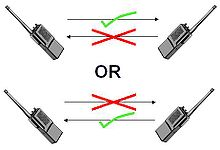Duplex
A duplex communication system is a point-to-point system composed of two or more connected parties or devices that can communicate with one another in both directions.
Systems that do not need duplex capabilities may instead use simplex communication, in which one device transmits and the others can only listen, such as broadcast radio and television, garage door openers, aby monitors, wireless microphones, and surveillance cameras.
Full Duplex

In a full-duplex system, both parties can communicate with each other simulateneously.
An example is a plain old telephone service; the parties at both ends of a call can speak and be heard by the other party simultaneously.
There is a technical distintion between a full-duplex communication using a single physical communication channel for both directions simultaneously and dual-simplex communication that uses two distinct channels, one for each direction.
No collisions
Full-duplex has several benefits over the use of half-duplex. Since there is only one transmitter on each twisted pair there is no contention and no collisions so time is not wasted by having to wait or retransmit frames.
Echo Cancellation
Full-duplex audio systems like telephones can create echo, which occurs when the sound originating from the far end comes out of the speaker at the near end, and re-enters the microphone there and, is then sent back to the far end. The sound then reappears at the original source end but delayed.
Echo cancellation is a singal-processing operation that substracts the far-end signal from the microphone signal before it is sent back over the network. It is an important technology allowing modems to achieve good full-duplex performance.
Half Duplex

In a half-duplex or semiduplex system, both parties can communicate with each other, but not simultaneously; the communication is one direction at a time.
An example is a walkie-talkie, a two-way radio that has a push-to-talk button, which turns on the transmitter and turns off the receiver.
Half-duplex systems are usuallly used to conserve bandwith since only a single communication channel is needed and is shared alternately between the two directions.
Collisions
In half-duplex systems, if more than one party transmits at the same time, a collision occurs, rsulting in lost or distorted messages.
Time-division multiplexing
In automatic communications systems suh as two-way data-links, time-division multiplexing can be used for time allocations for communications in a half-duplex system.
For example, station A on one end of the data link could be allowed to transmit for exactly one second, then station B on the other end could be allowed to transmit for exactly one second, and then the cycle repeats. In this scheme, the channel is never left idle.